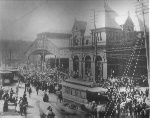Downtown Trains and Traffic
Traffic Trouble
Birmingham
was founded along a railroad, the way other cities were founded along a
river. In either case, it becomes important that folks can move across,
from one side of town to the other. As Birmingham grew, it became apparent
that the conflict between rail traffic and street traffic was a serious
issue. Not only were there pedestrians, horses, and wagons, but later
there were streetcars, as well as cars and trucks.
This view shows a special event by Birmingham View photography studio at the L & N Station, located at 20th Street South. You can see how congested the streets were.
Birmingham was started as an industrial city by people interested in mechanical improvements. The railroad exemplified this, as did the early development of street railways, including horsecars, steam "dummies" and electric streetcars. So, mobility and the expectation that people and goods should move efficiently in the Magic City, were important to city leaders.
But like many important improvements, someone has to put money on the table, and in Birmingham, everyone wanted to solve the traffic problem, but no one wanted to pay for it. At the railroad reservation, where traffic conflicts developed between busy streets and busy railroads, it took years to determine who should pay to separate the railroad tracks from the streets.
Some wanted to raise the streets, and some wanted to raise the railroad. But thrift minded politicians thought that the railroad companies ought to pay a share, and the debate continued for years, going all the way to the Alabama Supreme Court in 1927.
Read and see more about the Grade Separation.
Some history about street and railroad separation in Birmingham
Railway Age article about the Grade Separation Project
L&N Magazine Articles about the Grade Separation Project
January, 1932 May, 1933 Thanks to Lee Singletary for providing the scans of the these articles from the 1930's.
Aerial view of grade separation construction Thanks to Marv Clemons for this wonderful image from about 1930.
Streetcars and Public Transit
Birmingham had an extensive streetcar system which is well documented in the book Street Railways of Birmingham, listed in the bibliography section of this web site. Today, there is an interest in developing so called light rail systems as an aid to traffic congestion and as a tourist attraction to link the Convention Center to the Five Points Entertainment District. It is ironic that the dual streetcar tracks in 20th Street South were removed in 1995.
There is an interesting map attached here, which was copied from a 1926 issue of Birmingham Magazine, available in the Library, and listed in the bibliography section of this web site. This map was intended to tout the various improvements in the downtown traffic control system, which utilized "traffic control towers" and new "traffic control signals". Of interest in the map are the names of many of the key downtown buildings and the layout of the street car tracks.
Downtown Traffic Map. There is more to this map than meets the eye -- let the mouse explore.
Passenger Train Service
Today, Birmingham enjoys AMTRAK passenger train service, part of the former Southern Crescent route, from Washington to New Orleans. In the past, Birmingham enjoyed a variety of passenger trains serving travel to all major cities. A passenger train schedule is attached, which indicates the nature of this service. The schedule was copied from the March, 1929, issue of Birmingham Magazine.
Passenger Train Schedule A review of the schedule shows that Birmingham travelers enjoyed 47 passenger trains per day, served by 9 railroads.

